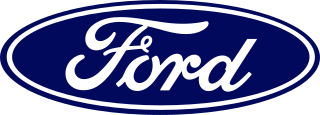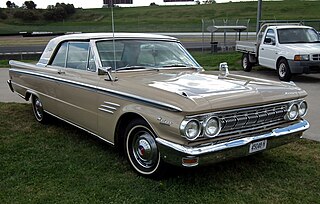
Edsel is a discontinued division and brand of automobiles that was produced by the Ford Motor Company in the 1958 to 1960 model years. Deriving its name from Edsel Ford, son of company founder Henry Ford, Edsels were developed in an effort to give Ford a fourth brand to gain additional market share from Chrysler and General Motors. Established as an expansion of the Lincoln-Mercury Division to three brands, Edsel shared a price range with Mercury; the division shared its bodies with both Mercury and Ford.

Mercury was a brand of mid-priced automobiles produced by American manufacturer Ford Motor Company between 1938 and 2011 with 1939 being the first model year. It stood as its own line within Ford until 1945, and thereafter formed half of Ford's Lincoln-Mercury Division. Created by Edsel Ford in 1938 to bridge the gap between the Ford and Lincoln model lines, its principal competition was General Motors' Buick and Oldsmobile divisions, and Chrysler Corporation's DeSoto and Chrysler brands.

The Ford FE engine is a V8 engine produced by the Ford Motor Company and used in vehicles sold in the North American market between 1958 and 1976. The FE, derived from 'Ford-Edsel', was introduced to replace the short-lived Ford Y-block engine, which American cars and trucks were outgrowing. It was designed with room to be significantly expanded, and manufactured both as a top-oiler and side-oiler, and in displacements between 332 cu in (5.4 L) and 428 cu in (7.0 L).

Ford Motor Company of Australia Limited is the Australian subsidiary of United States-based automaker Ford Motor Company. It was founded in Geelong, Victoria, in 1925 as an outpost of Ford Motor Company of Canada, Limited. At that time, Ford Canada was a separate company from Ford USA. Henry Ford had granted the manufacturing rights of Ford motor vehicles in the British Empire, to Canadian investors.
Special Vehicle Operations (SVO) is a term used throughout Ford Motor Company's global operations as a performance group, first used in America as Ford's own "speed shop", with a separate budget from Ford's regular operations. In 1993, the group was renamed Special Vehicle Team (SVT). As of 2015, SVO had been owned by Jaguar Land Rover, creating high performance versions of models such as the Jaguar F-Type and Range Rover Sports.
The Ford Motor Company produced straight-six engines from 1906 until 1908 and from 1941 until 2016. In 1906, the first Ford straight-six was introduced in the Model K. The next was introduced in the 1941 Ford. Ford continued producing straight-six engines for use in its North American vehicles until 1996, when they were discontinued in favor of more compact V6 designs.

Ford Group Philippines, Inc. (FGPI) is a Philippine-based subsidiary of Ford Motor Company. It was primarily focused on manufacturing automobiles for local and regional markets from 1998 until 2012. It built the Ford Escape, Ford Laser/Lynx, Ford Focus, Mazda3, and Mazda Tribute for the Philippines, Thailand, Indonesia, Singapore, Malaysia and Vietnam. Since 2012, Ford Philippines imports the vehicles it sells to the Philippine market. These imports come mostly from Thailand and the United States.

The Ford River Rouge complex is a Ford Motor Company automobile factory complex located in Dearborn, Michigan, along the River Rouge, upstream from its confluence with the Detroit River at Zug Island. Construction began in 1917, and when it was completed in 1928, it was the largest integrated factory in the world, surpassing Buick City, built in 1904.

The Mercury Meteor is an automobile that was produced by Mercury from the 1961 to 1963 model years. Adopting its nameplate from the namesake Ford of Canada brand, the Meteor was introduced as the base-trim full-size Mercury sedan, while the compact Mercury Comet shared a naming convention associated with the ongoing Space Race of the early 1960s. Slotted below the Mercury Monterey, the Meteor was the Mercury counterpart of the Ford Fairlane.

Fremont Assembly was a General Motors automobile factory in Fremont, California, in the San Francisco area, replacing the older Oakland Assembly. Groundbreaking for the plant occurred in September 1961, and the plant produced its first vehicle on May 1, 1963. Production continued through March 1, 1982, when the plant was closed after production problems. After closure, the plant was refurbished and reopened as the more successful NUMMI joint-venture between GM and Toyota between 1984 and 2010, and later became the Tesla Factory in 2010.

The Oakville Assembly Complex is a Ford Motor Company of Canada automobile factory in Oakville, Ontario, spanning 487 acres. This landmark occupies the same site as, and combines, the former Ontario Truck plant and Oakville Assembly Plant. Clearly visible from the Queen Elizabeth Way and the Lakeshore West GO Train line, it relies on the nearby railway service to transport parts and vehicles throughout the country.

The Ford Falcon is a model line of cars that was produced by Ford from the 1960 to 1970 model years. Though preceded by the Rambler American, the Falcon was the first compact car marketed by the Big Three American manufacturers.

Kansas City Assembly Plant (KCAP) is a Ford Motor Company automobile assembly facility which produces the Ford F-150 and the Ford Transit. It is located in Claycomo, Missouri, United States, about 10 miles (16 km) northeast of Kansas City, Missouri. It consists of 4.7 million square feet (440,000 m2) of production space and employs approximately 9,468 hourly workers represented by the United Auto Workers Local 249. It is the largest car manufacturing plant in the United States in terms of vehicles produced.

The Ford Maverick is a compact car manufactured and marketed by Ford for model years 1970–1977 in the United States, originally as a two-door sedan employing a rear-wheel drive platform original to the 1960 Falcon — and subsequently as a four-door sedan on the same platform. The Maverick replaced the Falcon in most of the world, but Australia kept selling and developing the Falcon.

Ford Argentina S.C.A. is the Argentine subsidiary of Ford Motor Company founded in Buenos Aires in 1913. Its first products were Model Ts assembled from complete knock down (CKD) kits provided by Ford Motor Company in 1917. Nevertheless, Ford Motor Argentina is best known in more recent times for producing the Ford Focus and, previously, the Argentine version of the Ford Falcon, originally a U.S. model introduced in Argentina in 1961, but adapted to the Argentine market.
The Louisville Assembly Plant is an automobile manufacturing plant owned by Ford Motor Company in Louisville, Kentucky. Opened in 1955, the 3,154,173-square-foot (293,032.3 m2) plant on 180 acres currently employs a total of 4,554 people. It is located adjacent to the Louisville International Airport on the south side of the city. Ford also operates another plant in Louisville, Kentucky Truck Assembly. The plant houses approximately 20.1 miles (32.3 km) of conveyor belts.

Ford Motor Company is an American multinational automobile manufacturer headquartered in Dearborn, Michigan, United States. It was founded by Henry Ford and incorporated on June 16, 1903. The company sells automobiles and commercial vehicles under the Ford brand, and luxury cars under its Lincoln brand. Ford also owns a 32% stake in China's Jiangling Motors. It also has joint ventures in China, Taiwan, Thailand, and Turkey. The company is listed on the New York Stock Exchange and is controlled by the Ford family; they have minority ownership but the majority of the voting power.
The Ford 9-inch is an automobile axle manufactured by Ford Motor Company. It is known as one of the most popular axles in automotive history. It was introduced in 1957 model year cars and ended production in 1986, having been phased out in favor of the Ford 8.8 inch axle. However, aftermarket companies still produce the 9-inch design. It is a semi-floating drop-out axle and had a GAWR up to 3,600 lb (1,630 kg).
Edison Assembly, also known as Metuchen Assembly, was a Ford Motor Company manufacturing plant in Edison, New Jersey. It was located at 939 U.S. Route 1 and occupied over 100 acres when it was open. The factory began operations in 1948 and closed on February 27, 2004. Several popular Ford products were manufactured there, such as the Ford Mustang, Ford Ranger, and the Ford Pinto. When the plant opened, it manufactured the new Mercury branded and Lincoln vehicles. It was one of three Ford manufacturing facilities in New Jersey and was built two years before the Mahwah Assembly plant was opened in 1950.
The Ford Pilot Plant facility, located at 17000 Oakwood Boulevard in Allen Park, Michigan, was opened in the summer of 1956 as the original location for the newly created Continental Division, where all Continental Mark II cars were assembled. It was renamed the Edsel Division Headquarters until 1959, when Edsel was discontinued and later became the New Model Programs Development Center facility, where new models are tested and developed. The role of the pilot plant is to test manufacture new products for the first time, documenting the steps and procedures, before assembly line production begins at the designated factory. The location can manufacture several vehicles at one time, where products are moved from station to station on mobile carriages until the process is complete.















